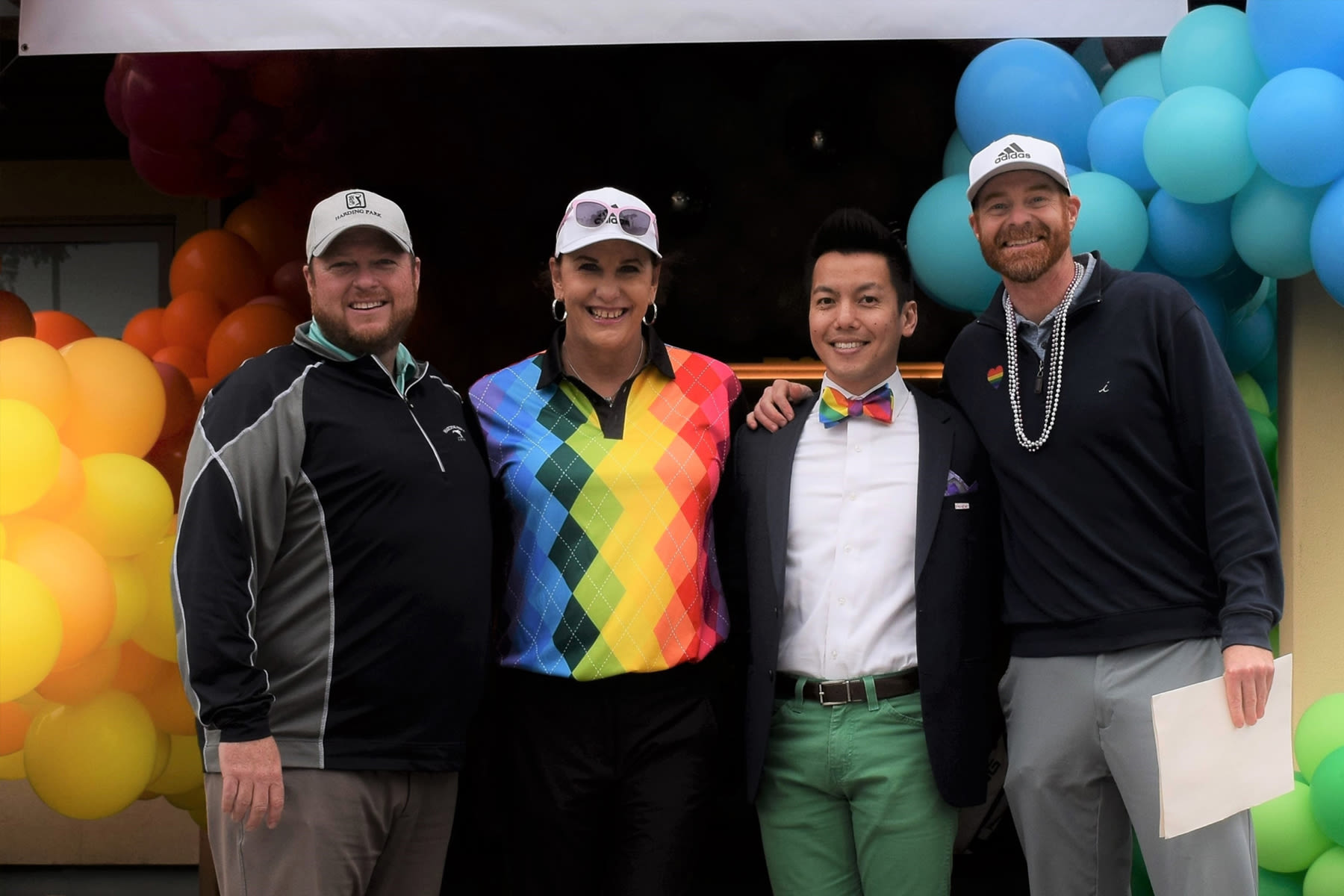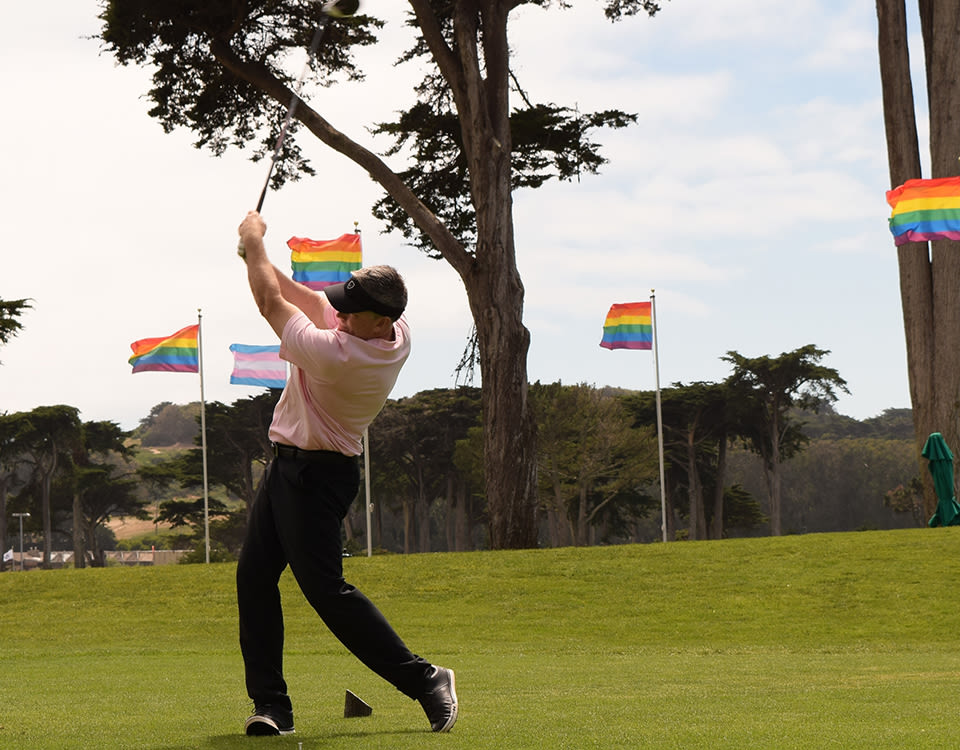From the PGA
Welcoming the LGBTQ Community to the Golf Course
By Charles Dillahunt and Chris Noble
Published on

This article was originally published in 2020.
Why is it important to welcome the LGBTQ community?
It’s important because for years the Lesbian, Gay, Bisexual, Transgender and Questioning (LGBTQ) community has been cast out of many popular sports cultures, evoking emotions of despair and anxiety for community members who wanted to engage with a new sport.
The golf industry is currently studying new ways to further their inclusion efforts, with many working to engage the historically unengaged LGBTQ community. Pride Month is celebrated throughout June and provides a special opportunity to step back, reflect and suggest ways you can be proactive in inviting the LGBTQ community to participate in the game of golf.
It’s a Matter of Pride
Pride, and the marches, were created in response to the Stonewall Riots and through the years the celebrations of remembrance for those lost to HIV, and those who have dealt with discrimination and hate crimes has grown. Now, Pride month is so big because corporations have found it to be a valuable way to reach the audience with such huge spending power. Golf is really no different but is more cautious about reaching out and supporting the community.
One year ago, the Northern California PGA Section and San Francisco Pride jointly presented their first-ever Pride Golf Outing as a fundraiser at TPC Harding Park (which is also scheduled to host the 2020 PGA Championship in August). The event was led by PGA Professional Greg Fitzgerald and members of SF Pride’s Board of Directors.
The main goal of the golf outing was to bring the LGBTQ community and its allies together in an environment that was safe, welcoming and equitable, and hosted in the spirit of San Francisco Pride. Participants enjoyed a fun and easy format, as each group was joined on the course by a local PGA Professional. The event was considered a success, as it inspired several participants to further play the game.
It’s important to keep in mind that what may work for an urban city in California may not work exactly the same way for a rural community in Indiana. Certain areas of the country may require more effort in the areas of safety requirements and greater education efforts to help others truly understand why including this community through certain strategic efforts is necessary. So, you will need to adapt to what works best in your local community.
Steps to Inclusion

There are actionable steps that golf course operators and regular everyday golfers alike can take to include more LGBTQ presence in golf. Start by asking...
- Do we take the time to welcome the LGBTQ community authentically? If not, how can we begin to do so?
- Does our facility target and market events to non-traditional households?
- Are there unique opportunities that we can now explore to create meaningful experiences for golfers within the LGBTQ community?
Taking a Closer Look at Your Club’s Inclusiveness

Similar to other strategies used when implementing a nine-hole women’s league, youth development program or transitioning from a private to a semi-private club, there are various steps you and your facility could take when it comes to including the LGBTQ community.
- Create Visibility - Seeing is believing. Creating visibility of your commitment to an inclusive golf facility will let people know they are welcome at your course or club. It can be as simple as posting a Human Rights Campaign (HRC) sticker or Pride flag sticker in your golf shop window. The HRC logo is a bright yellow “equals” sign laid against a dark blue background - one of the most recognizable symbols of the LGBTQ community and their fight for equal rights. You can receive free HRC or Pride stickers for free as well!
- Form a dialogue not a monologue - “How can we create a more welcoming space for the LGBTQ community?” This question should be posed to your fellow staff members, as well as to your Women’s Club Board, Men’s Club Board, and even your local LGBTQ Center. Speaking with all of your golf shop operations staff and regulars who play your course on the culture and language used in the shop or around the course can open up a conversation on how to foster an environment that is welcoming to all.
Invite the Community In and Make Their First Experience Memorable and Worthwhile
Nothing matters more to a person than how others address them, either by their name or otherwise.
- First impressions are key - To include the LGBTQ community when listing family events for club members and visitors, instead of putting husband and wife, try incorporating language such as “spouse” or “partner.” The small gestures and changes in language go a long way in letting that community know your facility is a safe space. By using imagery of same-sex couples and families, this language can also be visual, so that the LGBTQ community can see that they belong at your facility.
- Create unique invitational opportunities - When local health authorities allow your community to host group gatherings, your course or club can offer a Pride night, an LGBTQ & Friends League night, or even a Pride-themed golf outing. These events are for everyone, but making them so that they target the LBGTQ community and welcomes them to engage with your staff, membership and guests can help form a unique bond that sets your course apart. Your local LGBTQ Community Center can help you develop ideas for making a memorable and fun event.
- Represent diverse lifestyles - People tend to gravitate towards brands and companies that they feel represent them. Those who are able to authentically engage with non-traditional communities after following the steps mentioned above will most likely gain the LGBTQ community’s trust and business.
Create Meaningful Relationships
Adding visuals can help affirm your intention to welcome those from non-traditional households and communities, but how can this be accomplished authentically?
Consider incorporating marketing materials with a gay couple sitting by the pool at your facility. Perhaps you post an image of an lesbian couple on the course with their son or daughter playing nine holes. Maybe you show a transgender youth who participated in a junior clinic with your PGA Professional on your website.
Over time, members of the LGBTQ community can serve as ambassadors to welcome other new golfers to your facility. The most important thing is to try new methods of promotion to include more individuals, as it is a win-win for growing the game and will help ensure that golf belongs to everyone.